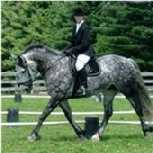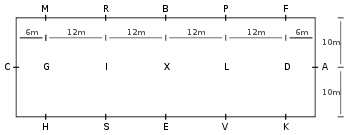

The word Dressage
originates from the French word, dresser, which means to train.
Today, the term Dressage is used to describe a type of training method
and a competitive equestrian sport which strives for high levels of
precision and harmony between horse and rider. The
object of Dressage is to progressively develop a horse's physical and
mental ability to where the horse can remain calm,
consistent, supple,
attentive and keen to the aids of the rider. At the highest levels,
communication between horse and rider becomes virtually invisible,
creating the illusion that the horse and rider are performing 'as
one'.
The
United States Equestrian Federation
(USEF) established six official levels of competition standardized
throughout the United States: Training, First, Second, Third, and
Fourth. Training is the level of least difficulty and Fourth is the
level having more difficulty.
The
International Equestrian Federation
(FEI) established four additional levels of competition which are
standardized throughout the world: Prix St. George, Intermediare I,
Intermediare II and Grand Prix, with Grand Prix being the highest
level of all Dressage Competition.
Each level has
appropriately, pre-choreographed 'tests' which competitors perform,
individually, in front of a highly qualified judge. As each movement
of the test is executed, it is numerically rated from 0 to 10, 10
being the highest possible score for any given movement. All the
scores are then added, assigned a percentage rating and compared to
other competitors scores in the same test and level.
As explained
in
Wikipedia, the Free Internet Encyclopedia
DRESSAGE
(pronounced dress-ahhzh /ˈdrɛsɑʒ/) (a
French term, most commonly translated
to mean
"training") is
a path and
destination of competitive
horse training, with competitions
held at all levels from amateur to the
Olympics. Its fundamental purpose is to develop, through standardized
progressive training methods, a horse's natural athletic ability and
willingness to perform, thereby maximizing its potential as a
riding horse. At the peak of a dressage horse's gymnastic development,
it can smoothly respond to a skilled rider's minimal aids by performing the
requested movement while remaining relaxed and appearing effortless.
Dressage is occasionally referred to as "Horse
Ballet" (cf.
nl:Dressuur). Although the discipline has ancient roots, dressage
was first recognized as an important equestrian pursuit in the West during
the
Renaissance. The great European riding masters of that period developed
a sequential training system that has changed little since then.
Classical dressage is still considered the basis of trained modern
dressage.
Early European
aristocrats displayed their horses' training in equestrian
pageants, but in modern dressage competition, successful
training at the various levels is demonstrated through the performance
of "tests" of prescribed series of movements within a standard arena. Judges
evaluate each movement on the basis of an objective standard appropriate to
the level of the test and assign each movement a score from
zero to ten - zero being "not executed" and 10 being "excellent". A
score of 9 is considered "very good" and is considered a particularly high
mark, while a competitor achieving all 6s (or 60% overall) should be
considering moving on to the next level.
There is nothing more breathtaking than watching
dressage Olympic competition, as these horses move and "dance" in a stylized
manner. Expert dressage riders' cues to their mounts should be imperceptible.
The team appears to be working in a partnership reminiscent of highly skilled
dancers performing a pas de deux in ballet, with two dancers moving
effortlessly in rhythm, choreographing a brilliantly flowing motion. As
the dressage horse and rider become more proficient in training, their levels
of competition are more exacting. Gait changes, speed and collection that
appears to emanate by imperceptible communication are the hallmarks of a great
partnership between horse and rider. It takes years of exacting training and
hard work to achieve this. Many great dressage horses appear to enjoy
performing and competition.
There are several levels of dressage, each
more difficult as the levels progress, and two forms, classical and
competitive. Classical dressage requires a much greater and
more strenuous effort on the part of the horse. Horses are asked to perform "aires
above the ground," which are not a natural part of the horse's movements.
Rooted in military arts, where horses were trained to attack adversaries by
kicking, striking out and rearing maneuvers, this aspect of dressage is one
for which the Lippizaner Stallions are famous.
Competitive dressage, on the other hand, is based on the natural moves
that are part of horses' gaits such as the Piaffe, Passage, Half-pass,
Extended Trot and Tempi Changes. Videos of the upper level
movements are available at
Wikipedia.com under "Olympic Level"
USEF INFORMATION ABOUT DRESSAGE
 The
United States Equestrian Federation
(USEF) established six official levels of competition standardized throughout
the United States: Training, First, Second, Third, and Fourth. Training is the
level of least difficulty and Fourth is the level having more difficulty. The FEI established four additional levels of competition which are standardized
throughout the world: Prix St. George, Intermediare I, Intermediare II and
Grand Prix, with Grand Prix being the highest level of all Dressage
Competition. Each level has appropriately, pre-choreographed 'tests'
which competitors perform, individually, in front of a highly qualified judge.
As each movement of the test is executed, it is numerically rated from 0 to
10, 10 being the highest possible score for any given movement. All the scores
are then added, assigned a percentage rating and compared to other competitors
scores in the same test and level.
The
United States Equestrian Federation
(USEF) established six official levels of competition standardized throughout
the United States: Training, First, Second, Third, and Fourth. Training is the
level of least difficulty and Fourth is the level having more difficulty. The FEI established four additional levels of competition which are standardized
throughout the world: Prix St. George, Intermediare I, Intermediare II and
Grand Prix, with Grand Prix being the highest level of all Dressage
Competition. Each level has appropriately, pre-choreographed 'tests'
which competitors perform, individually, in front of a highly qualified judge.
As each movement of the test is executed, it is numerically rated from 0 to
10, 10 being the highest possible score for any given movement. All the scores
are then added, assigned a percentage rating and compared to other competitors
scores in the same test and level.
THE
DRESSAGE ARENA(S)
 There are two sizes of arenas: small and standard. The small arena is 20
meters by 40 meters, and is used for the lower levels of dressage and 3-day eventing dressage. The standard arena is 20 meters by 60 meters, and is used
for upper-level tests. Dressage arenas have a lettering system around their
outside in the order (clockwise) A-K-E-H-C-M-B-F (small arena) and
A-K-V-E-S-H-C-M-R-B-P-F (standard arena). At the start of the test, the horse
enters at A. There is always a judge sitting at C (although for upper-level
competition, there is generally more than one judge at a second or third place
around the arena, and in some competitions there can be 5 judges located
around the arena). The invisible letter X is always in the center of the
dressage arena. The dressage arena also has a centerline (from A to C,
going trough X in the middle), as well as two quarter-lines (halfway between
the centerline and long sides of each arena).
There are two sizes of arenas: small and standard. The small arena is 20
meters by 40 meters, and is used for the lower levels of dressage and 3-day eventing dressage. The standard arena is 20 meters by 60 meters, and is used
for upper-level tests. Dressage arenas have a lettering system around their
outside in the order (clockwise) A-K-E-H-C-M-B-F (small arena) and
A-K-V-E-S-H-C-M-R-B-P-F (standard arena). At the start of the test, the horse
enters at A. There is always a judge sitting at C (although for upper-level
competition, there is generally more than one judge at a second or third place
around the arena, and in some competitions there can be 5 judges located
around the arena). The invisible letter X is always in the center of the
dressage arena. The dressage arena also has a centerline (from A to C,
going trough X in the middle), as well as two quarter-lines (halfway between
the centerline and long sides of each arena). 
 INFORMATION
FROM NODA
INFORMATION
FROM NODA
Lead-Line Dressage Classes -- Offered at several NODA Schooling Shows allow
very young riders to experience Dressage competitions.
Dressage Terminology
Definitions
USDF Spectator's Guide to
Dressage
WELCOME PAGE
TOP OF THIS PAGE